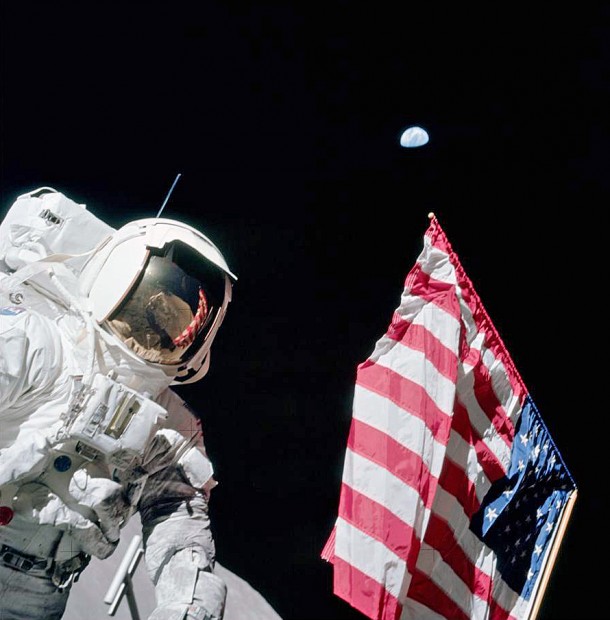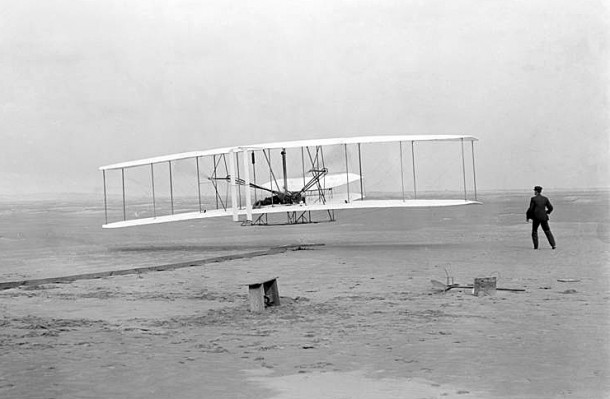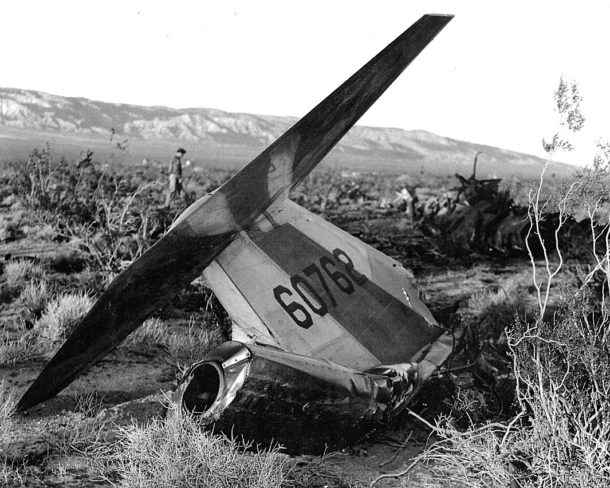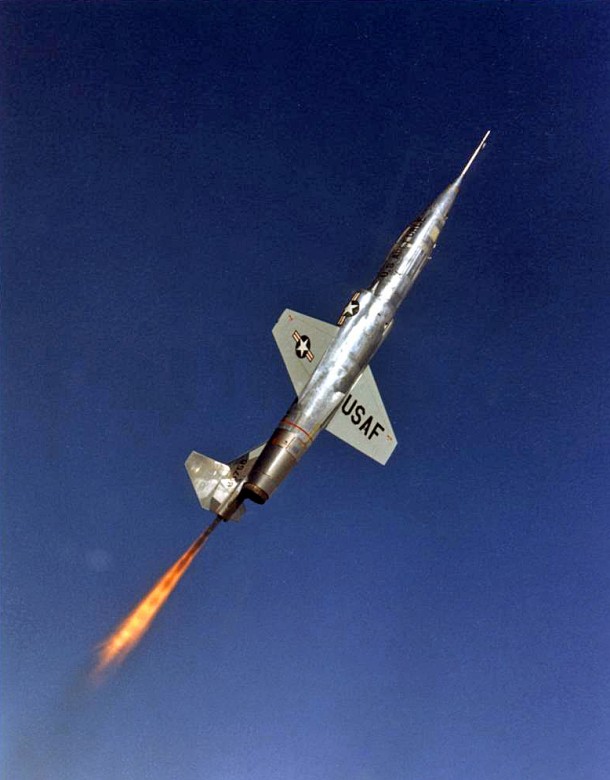
Forty-seven years ago this month, NASA successfully conducted the sixth lunar landing mission of the Apollo Program. Known as Apollo 17, the flight marked the last time that men from the planet Earth explored the surface of the Moon.
Apollo 17 was launched from LC-39A at Cape Canaveral, Florida on Thursday, 07 December 1972. With a lift-off time of 05:33:00 UTC, Apollo 17 was the only night launch of the Apollo Program. Those who witnessed the event say that night turned into day as the incandescent exhaust plumes of the Saturn V’s quintet of F-1 engines lit up the sky around the Cape.
The target for Apollo 17 was the Taurus-Littrow valley in the lunar highlands. Located on the southeastern edge of Mare Serenitatis, the landing site was of particular interest to lunar scientists because of the unique geologic features and volcanic materials resident within the valley. Planned stay time on the lunar surface was three days.
The Apollo 17 crew consisted of Commander Eugene A. Cernan, Command Module Pilot (CMP) Ronald E. Evans and Lunar Module Pilot (LMP) Harrison H. Schmitt. While this was Cernan’s third space mission, both Evans and Schmitt were space rookies. Astronaut Schmitt was a professional geologist and the only true scientist to explore the surface of the Moon.
With Evans circling the Moon solo in the Command Module America, Cernan and Schmitt successfully landed their Lunar Module Challenger at 19:54:57 UTC on Monday, 11 December 1972. Their lunar stay lasted more than three days. The astronauts used the Lunar Rover for transport over the lunar surface as they conducted a trio of exploratory excursions that totaled more than 22 hours.
Cernan and Schmitt collected nearly 244 pounds of lunar geologic materials while exploring Taurus-Littrow. As on previous missions, the Apollo 17 crew deployed a sophisticated set of scientific instruments used to investigate the lunar surface environment. Indeed, the Apollo Lunar Surface Experiments Package (ALSEP) deployed during during lunar landing missions measured and transmitted vital lunar environmental data back to Earth through September 1977 when the data acquisition effort was officially terminated.
The Apollo 17 landing party departed the Moon at 22:54:37 UTC on Thursday, 14 December 1972. In a little over two hours, Challenger and America were docked. Following crew and cargo transfer to America, Challenger was later intentionally deorbited and impacted the lunar surface. The Apollo 17 crew then remained in lunar orbit for almost two more days to make additional measurements of the lunar environment.
At 23:35:09 UTC on Saturday, 16 December 1972, Apollo 17 blasted out of lunar orbit and headed home. Later, CMP Ron Evans performed a trans-Earth spacewalk to retrieve film from Apollo 17 ’s SIM Bay camera. Evans’ brave spacewalk occurred on Sunday, 17 December 1972 (69th anniversary of the Wright Brothers first powered flight) and lasted 65 minutes and 44 seconds.
Apollo 17 splashdown occurred near America Samoa in the Pacific Ocean at 19:24:59 UTC on Tuesday, 19 December 1972. America and her crew were subsequently recovered by the USS Ticonderoga.
Apollo 17 set a number of spaceflight records including: longest manned lunar landing flight (301 hours, 51 minutes, 59 seconds); longest lunar stay time (74 hours, 59 minutes, 40 seconds); total lunar surface extravehicular activity time (22 hours, 3 minutes, 57 seconds); largest lunar sample return (243.7 pounds), and longest time in lunar orbit (147 hours, 43 minutes, 37 seconds).
Apollo 17 successfully concluded America’s Apollo Lunar Landing Program. Of a sudden it seemed, America’s — and the world’s — greatest adventure was over. However, the anticipation was that the United States would return in the not-too-distant future. Indeed, Gene Cernan, the last man to walk on the Moon, spoke the following words from the surface:
“As I take man’s last step from the surface, back home for some time to come — but we believe not too long into the future — I’d like to just [say] what I believe history will record — that America’s challenge of today has forged man’s destiny of tomorrow. And, as we leave the Moon at Taurus-Littrow, we leave as we came and, God willing, as we shall return, with peace and hope for all mankind. Godspeed the crew of Apollo 17.”
It has now been 47 years since the Commander of Apollo 17 spoke those stirring words from the valley of Taurus-Littrow. Gene Cernan passed away in January of 2017. He and most space experts of his day figured we would surely have returned to the Moon by now. Certainly in the 20th century. Yet, there has been no return. Thus, the historical record continues to list the name of Eugene A. Cernan as the last man to walk on the surface of the Moon.

One-hundred and sixteen years ago today, the Wright Flyer became the first aircraft in history to achieve powered flight. The site of this historic event was Kill Devil Hills located near Kitty Hawk, North Carolina.
Americans Wilbur and Orville Wright began their legendary aeronautical careers in 1899. In a matter of just four short years, the brothers would go from complete aeronautical novices to inventors and pilots of the world’s first successful powered aircraft. Neither man attended college nor received even a high school diploma.
The Wright Flyer measured roughly 21 feet in length and had a wing span of approximately 40 feet. The biplane aircraft had an empty weight of 605 lbs. Power was provided by a single 12 horsepower, 4-cylinder engine that drove twin 8.5 foot, two-blade propellers.
The Flyer made a powered take-off run along a 60-foot wooden guide rail. The aircraft was mounted on a two-wheel dolly that rode along the track and was jettisoned at lift-off. The Flyer pilot lay prone in the middle of the lower wing. Twin elevator and rudder surfaces provided pitch and yaw control, respectively. Roll control was via differential wing warping.
The Wright Brothers had come close to achieving a successful powered flight with the Wright Flyer on Monday, 14 December 1903. Wilbur, who had won the coin toss, was the pilot for the initial attempt. However, the Flyer stalled and hit the ground sharply just after take-off. Wilbur was unhurt, but repair of the damaged aircraft would take two days.
The next attempt flight took place on Thursday, 17 December 1903. The weather was terrible. Windy and rainy. Even after the rain abated, the wind continued to blow in excess of 20 mph. The Wrights decided to fly anyway. It was now Orville’s turn as command pilot.
Orville took his position on the Flyer and was quickly launched into the wind. Once airborne, the aircraft proved difficult to control as it porpoised up and down along the flight path. Nonetheless, Orville kept the Flyer in the air for 12 seconds before landing 120 feet from the take-off point. Other than a damaged skid, the aircraft was intact and the pilot unhurt. Powered flight was a reality!
Three more flights followed on that momentous occasion as the two brothers alternated piloting assignments. The fourth flight was the longest in both time aloft and distance flown. With Wilbur at the controls, the Wright Flyer flew for 59 seconds and landed 852 feet from the take-off point.
The Wright Brothers father, Milton, would soon learn of the epic events that December day in North Carolina. Orville’s verbatim Western Union telegram message sent to Dayton, Ohio read:
Success four flights thursday morning all against twenty one mile wind started from level with engine power alone average speed through air thirty one miles longest 57 [sic] seconds inform press home Christmas.

Fifty-six years ago to the day, USAF NF-104A (S/N 56-762; Ship 3) crashed to destruction following a rocket-powered zoom to 101,600 feet above mean sea level (AMSL). The pilot, USAF Colonel Charles E. “Chuck” Yeager, was seriously injured, but survived when he successfully ejected from the stricken aircraft approximately 5,000 feet above ground level (AGL).
The USAF/Lockheed NF-104A was designed to provide spaceflight-like training experience for test pilots attending the Aerospace Research Pilot School (ARPS) at Edwards Air Force Base, California. The type was a modification of the basic F-104A Starfighter aircraft. Three copies of the NF-104A were produced (S/N’s 56-0756, 56-0760 and 56-0762). It was the ultimate zoom flight platform.
In addition to a stock General Electric J79-GE-3 turbojet, the NF-104A was powered by a Rocketdyne LR121-NA-1 rocket motor. The J79 generated 15,000 pounds of thrust in afterburner and burned JP-4. The LR-121 produced 6,000 pounds of thrust and burned a combination of JP-4 and 90% hydrogen peroxide. Rocket motor burn time was on the order of 90 seconds.
Around 1400 hours PST on Tuesday, 10 December 1963, Colonel Yeager took-off from Edwards Air Force Base to attempt his second zoom flight of the day. That morning, he had zoomed NF-104A, S/N 56-760 to an altitude of 108,700 feet. Four days earlier, Yeager had zoomed the same airplane to the highest altitude he would ever achieve in the type; 110,500 feet AMSL.
The zoom apex altitude for the ill-fated afternoon flight was only 101,600 feet AMSL with rocket motor burnout taking place 5 seconds post-apogee. That is, the aircraft was already on the descending leg of the zoom trajectory and in the early stages of reentry. Yeager later reported that the aircraft angle-of-attack at that point was on the order of 50 deg; a figure that is well past the NF-104A pitch-up angle-of-attack (i.e., 14-17 deg). Yeager had flown the aircraft this way on previous zoom flights and had always been able to lower the nose via reaction control system (RCS) inputs.
Unfortunately, the RCS did not not have sufficient pitch control authority to bring the nose down on the mishap flight. As a result, the aircraft began the reentry in an extremely nose-high attitude. As the dynamic pressure rapidly built-up, the NF-104A departed controlled flight and went through a series of post-stall gyrations between 90,000 and 65,000 feet. These gyrations ultimately led to a series of flat spins occurring between 65,000 and 20,000 feet.
Running out of altitude, Yeager desperately deployed his drag parachute as an anti-spin device. This action indeed stopped the flat spin. Airspeed picked-up to 180 KIAS with the aircraft hanging in the chute, but the pilot was unable to get an air-start on his J79 turbojet which had spooled down to 6% of maximum RPM. At 12,000 feet, Yeager jettisoned his drag chute and the NF-104A immediately pitched-up again into a flat spin. After three-quarters of a turn, Yeager ejected about 5,000 feet AGL. Yeager landed close to where the mishap aircraft had impacted and was in a great deal of pain due to burns he received during the ejection process. Happily, he survived this traumatic event and recovered completely from his injuries.
Objective analysis of the loss of NF-104A, S/N 56-762 reveals that the aircraft simply was not flown in a manner commensurate with the intricacies of the zoom environment. The critical importance of quickly intercepting and maintaining the target inertial pitch angle during pull-up had been repeatedly demonstrated by other test pilots as had proper control of aircraft angle-of-attack during reentry. Colonel Yeager elected not to fly the aircraft in accordance with these dictates.
In all of his NF-104A zoom attempts, Colonel Yeager consistently flew the airplane over the top at angles-of-attack well beyond the pitch-up value. RCS control authority was sufficient to lower the nose to sub-pitch-up angles-of-attack just prior to reentry on all but the mishap flight. Unfortunately, the low apex altitude (101,600 feet AMSL) of that zoom resulted in a higher dynamic pressure that, in conjunction with very high angles-of-attack, produced a nose-up aerodynamic pitching moment that the RCS could not overcome.
The aircraft mishap of 10 December 1963 forever changed the way in which NF-104A pilots would be allowed to fly the rocket-powered zoom mission. Prior to the mishap, the NF-104A had been zoomed to an altitude of 120,800 feet AMSL by USAF Major Robert W. Smith on 06 December 1963. This unofficial United States record still stands today. After a mishap investigation, NF-104A maximum altitude was limited to 108,000 feet AMSL. This restricted performance was mandated ostensibly out of concern for the safety of ARPS student test pilots.
The ultimate and lasting result of the post-mishap restriction on NF-104A flight performance was that it did a great disservice to ARPS student test pilots in that it made their spaceflight training experience something less than what it could and should have been. It is ironic that, although the correct manner in which to zoom the airplane had been repeatedly validated by USAF and Lockheed test pilots prior to the 56-0762 mishap, the decision to restrict NF-104A performance was based on a single flight which clearly demonstrated how not to fly the airplane.

Fifty-six years ago to the day, USAF Major Robert W. Smith zoomed the rocket-powered USAF/Lockheed NF-104A to an unofficial world record altitude of 120,800 feet. This mark still stands as the highest altitude ever achieved by a United States aircraft from a runway take-off.
A zoom maneuver is one in which aircraft kinetic energy (speed) is traded for potential energy (altitude). In doing so, an aircraft can soar well beyond its maximum steady, level altitude (service ceiling). The zoom maneuver has both military and civilian flight operations value.
The USAF/Lockheed NF-104A was designed to provide spaceflight-like training experience for test pilots attending the Aerospace Research Pilot School (ARPS) at Edwards Air Force Base, California. The type was a modification of the basic F-104A Starfighter aircraft. Three copies of the NF-104A were produced (S/N’s 56-0756, 56-0760 and 56-0762). It was the ultimate zoom flight platform.
In addition to a stock General Electric J79-GE-3 turbojet, the NF-104A was powered by a Rocketdyne LR121-NA-1 rocket motor. The J79 generated 15,000 pounds of thrust in afterburner and burned JP-4. The LR-121 produced 6,000 pounds of thrust and burned a combination of JP-4 and 90% hydrogen peroxide. Rocket motor burn time was on the order of 90 seconds.
The NF-104A was kinematically capable of zooming to altitudes approaching 125,000 feet. As such, it was a combined aircraft, rocket, and spacecraft. The pilot had to blend aerodynamic and reaction controls in the low dynamic pressure environment near the zoom apex. He was also required to fly in a full pressure suit for survival at altitudes beyond the Armstrong Line.
On Friday, 06 December 1963, Bob Smith took-off from Edwards and headed west for the Pacific Ocean. Out over the sea, he changed heading by 180 degrees in preparation for the zoom run-in. At a point roughly 100 miles out, Smith then accelerated the NF-104A (S/N 56-0760) along a line that would take him just north of the base. Arriving at Mach 2.4 and 37,000 feet, Smith then initiated a 3.75-g pull to a 70-degree aircraft pitch angle. Turbojet and rocket were at full throttle.
Things happened very quickly at this point. Smith brought the J79 turbojet out of afterburner at 65,000 feet and then moved the throttle to the idle detent at 80,000 feet. The rocket motor burned-out around 90,000 feet. Smith controlled the aircraft (now spacecraft) over the top of the zoom using 3-axis reaction controls. The NF-104A’s arcing parabolic trajectory subjected him to 73 seconds of weightlessness. Peak altitude achieved was 120,800 feet above mean sea level.
On the back side of the zoom profile, Bob Smith restarted the windmilling J79 turbojet and set-up for landing at Edwards. He touched down on the main runway and rolled out uneventfully. Total mission time from brake-release to wheels-stop was approximately 25 minutes.
Much more could be said about the NF-104A and its unique mission. Suffice it to say here that two of the aircraft ultimately went on to serve in the ARPS from 1968 to 1971. The only remaining aircraft today is 56-0760 which sits on a pole in front of the USAF Test Pilot School (TPS) at Edwards.
Bob Smith went on to make many other noteworthy contributions to aviation and his nation. Having flown the F-86 Sabre in Korea, he volunteered to fly combat in Viet Nam in his 40th year. Stationed at Korat AFB in Thailand, he commanded the 34th Fighter Squadron of the 388th Tactical Fighter Wing. Smith flew 100 combat missions in the fabled F-105D Thunderchief; many of which involved the infamous Pack VI route in North Viet Nam.
Bob Smith was a true American hero. Like so many of the airmen of his day, Smith was a man whose dedication, service, and courage went largely unnoticed and underappreciated by his fellow countrymen. Bob Smith’s final flight came just 3 months shy of his 82nd birthday on Thursday, 19 August 2010.




